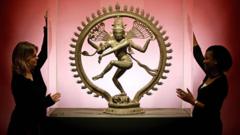Article:
In 1000 CE, as Europe struggled to shape its future, a magnificent empire thrived on the other side of the world. The Chola dynasty of southern India, under the rule of Emperor Rajaraja Chola, was on the verge of erecting a temple that would transcend all others. Just a decade later, the Brihadishvara temple would rise to a staggering height of 216 feet, built from 130,000 tonnes of granite, making it one of the tallest structures of its time, second only to the Egyptian pyramids. This architectural marvel housed a 12-foot tall gold-embellished idol of Shiva and showcased 60 stunning bronze sculptures, a testament to the wealth amassed through conquests.
Little known outside India, the Chola dynasty significantly shaped the medieval world. Emerging in the Kaveri floodplain, the Cholas distinguished themselves through innovation and influential leadership, particularly among women. Rajaraja’s great-aunt, Sembiyan Mahadevi, enhanced the family's image as devoted followers of Shiva and transformed them into public figures who redefined local spirituality through grand temples dedicated to Nataraja, a lesser-known form of Shiva.
Rajaraja himself was a fierce conqueror; in the late 990s, he led campaigns across India and established a lasting presence in the strategic island of Lanka. His military victories culminated in the creation of the Brihadishvara temple, which was supported by annual tributes of rice and vast economic resources aimed at expanding agricultural development. The scale of Chola governance was unprecedented, likened to a system that few states had ever imagined.
Following in Rajaraja's footsteps, his son Rajendra Chola expanded their reign by forming alliances with merchant corporations, creating a model of state and trade that predates future colonial enterprises. In 1026, he led expeditions to the Malay Peninsula, opening up new trade routes and facilitating the Tamil diaspora that flourished across Southeast Asia by the late 11th century.
Under the Chola, Tamil merchants ventured as far as China, establishing trade links and enduring cultural exchanges, laying the groundwork for Tamil influence that endures in modern Southeast Asia. As temples flourished into massive complexes and vibrant markets, urban centers emerged across the Kaveri region, rivaling the largest cities in Europe, celebrating a heterogeneous community intermingling diverse cultures and religions.
The Chola era witnessed incredible feats in artistry, reflected in their exquisite metalwork and widely-celebrated bronzes, particularly the Nataraja figures, which now grace museums around the world. Literary advancements flourished alongside artistic achievements, as Tamil poets crafted narratives that blended history with elements of magical realism, indicating a cultural Renaissance three centuries ahead of its European counterpart.
The Chola dynasty's legacy continues to resonate today, illustrated by the enduring architectural and cultural landmarks in Tamil Nadu, shaping a historical narrative that speaks of a vibrant, connected, and innovative past, influencing the world then and now.
In 1000 CE, as Europe struggled to shape its future, a magnificent empire thrived on the other side of the world. The Chola dynasty of southern India, under the rule of Emperor Rajaraja Chola, was on the verge of erecting a temple that would transcend all others. Just a decade later, the Brihadishvara temple would rise to a staggering height of 216 feet, built from 130,000 tonnes of granite, making it one of the tallest structures of its time, second only to the Egyptian pyramids. This architectural marvel housed a 12-foot tall gold-embellished idol of Shiva and showcased 60 stunning bronze sculptures, a testament to the wealth amassed through conquests.
Little known outside India, the Chola dynasty significantly shaped the medieval world. Emerging in the Kaveri floodplain, the Cholas distinguished themselves through innovation and influential leadership, particularly among women. Rajaraja’s great-aunt, Sembiyan Mahadevi, enhanced the family's image as devoted followers of Shiva and transformed them into public figures who redefined local spirituality through grand temples dedicated to Nataraja, a lesser-known form of Shiva.
Rajaraja himself was a fierce conqueror; in the late 990s, he led campaigns across India and established a lasting presence in the strategic island of Lanka. His military victories culminated in the creation of the Brihadishvara temple, which was supported by annual tributes of rice and vast economic resources aimed at expanding agricultural development. The scale of Chola governance was unprecedented, likened to a system that few states had ever imagined.
Following in Rajaraja's footsteps, his son Rajendra Chola expanded their reign by forming alliances with merchant corporations, creating a model of state and trade that predates future colonial enterprises. In 1026, he led expeditions to the Malay Peninsula, opening up new trade routes and facilitating the Tamil diaspora that flourished across Southeast Asia by the late 11th century.
Under the Chola, Tamil merchants ventured as far as China, establishing trade links and enduring cultural exchanges, laying the groundwork for Tamil influence that endures in modern Southeast Asia. As temples flourished into massive complexes and vibrant markets, urban centers emerged across the Kaveri region, rivaling the largest cities in Europe, celebrating a heterogeneous community intermingling diverse cultures and religions.
The Chola era witnessed incredible feats in artistry, reflected in their exquisite metalwork and widely-celebrated bronzes, particularly the Nataraja figures, which now grace museums around the world. Literary advancements flourished alongside artistic achievements, as Tamil poets crafted narratives that blended history with elements of magical realism, indicating a cultural Renaissance three centuries ahead of its European counterpart.
The Chola dynasty's legacy continues to resonate today, illustrated by the enduring architectural and cultural landmarks in Tamil Nadu, shaping a historical narrative that speaks of a vibrant, connected, and innovative past, influencing the world then and now.




















